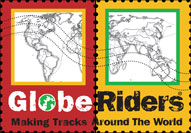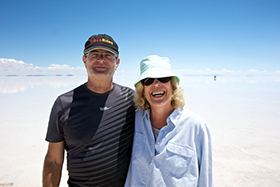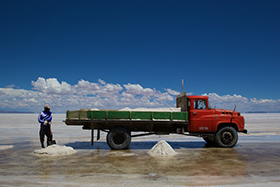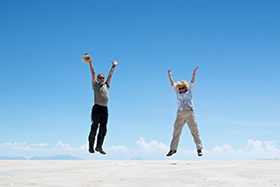Nazca to Potosi
In this chapter we enter in to some incredible riding as the road climb up in to the high Andes Mountains. Nazca was a great stop in the Atacama Desert where we had learned about the famous lines of Nazca. We also had a chance to visit an Inca cemetery that for many years had been a sad reminder of the greed of mankind. The graves had been dug up to rob the corpses of silver and gold. As many places in Latin America this had been done to fund the wars in Europe. When I first visited this Inca gravesite in 1987 there were literally hundreds of graves turned up side down, robed of its treasures and left exposed totally without respect for the culture. Today the site has been restored and well worth a visit. The ride to the site itself gave us a good opportunity to take pictures of each other on a great dirt road, see gallery below for images.
The two days ride from Nazca to Cusco is one of my personal favorites in Peru. The road is very good asphalt and it winds its way up and down mountains from sea level to 14,000 feet.
Small villages along the road make for good pit stops and a chance to meet the locals. Half way we stop for the night in a little Italian village with wooden huts made to lodge travelers. There is even a fishpond full of trout outside the restaurant where you can catch your own dinner. Apparently an Italian Peruvian couple had built the place. Not what one would expect in that part of the world, but certainly a welcomed place to stay after a long day on the road.
As we got closer to Cusco I stopped often to take pictures as in front of me I had a vista of incredible green valleys. The road snaked itself down the hillsides surrounded by small farms and one could smell the soil as farmers were working the fields; what a beautiful ride it was.
Cusco is the center for tourism in Peru where people from all over the world comes to see the remains of the Incas. There are plenty of Inca sites around the city that we spend a good part of a day to visit. However, there is nothing that can beat a visit to Machu Picchu. Not accessible by road we board a train one very early morning to ride to Aguas Caliente and from there a shuttle bus took us to the top of the mountain where the ruins of this Inca village sits on the ridge between mountains. It is truly a spectacular site to visit.
Together with Fred and Kainan we use our free day in Cusco to go for a ride of the Sacred Valley. We visit other Inca sites, but most of all we enjoy the ride that at this time of year is incredible with green fields. Kainan has us ride to see a salt mine that we later learn dates back to Inca times. Two separate springs come from deep underground and this water is channeled to literally hundreds of terrace pools where the water sits and evaporates and after about a month with repeated flooding and drying of the pools salt is extracted. Fascinating to think that this has been going on in more or less this same manner since the time of the Incas.
The worlds highest navigable lake is Lake Titicaca and it is here we visit the Uros floating reed villages, just outside the city of Puno. Today the place thrives on tourism and reminds one a little of a tourist trap. However at the other side it is very interesting to learn a little about how people have settled on the floating islands. Just walking around on the surface that is soft and knowing that you are on a floating island made of reeds makes the experience very surreal.
David had told the group prior to our departure that two of his bucket list items for this journey were Machu Picchu and the ruins of Tiwanaku. I had never been to Tiwanaku, but heard about it in the past as one of the most important precursors to the Inca Empire. We had now crossed from Peru to Bolivia and despite very interesting history and impressive ruins it was evident that Bolivia had not invested in the infrastructure to take full advantage of what could be a great tourist attraction. The Tiwanaku site was pre Inca and as we learned more about its history we started to form a picture of what the land would have been like so many years ago: 1500BC.
Gasoline is heavily subsidized by the government in Bolivia and for that reason people traveling with a foreign license plate have to pay a higher price for fuel. Sounds simple at first, but when you find yourself looking for selected places that are allowed to fill your foreign registered bikes it can be very frustrating. It is also evident that even the few stations in and around La Paz, the capital, which has the permit to fill our tanks, can be difficult to deal with. We found it easier if we got a group of bikes together and that way used the power of the numbers of bikes to get the tanks filled. Like anything in life at first it was frustrating, but as soon as we learned the game it was easier and less frustrating.
The ride from La Paz to Uyuni Salt Flats is a long day in the saddle with challenging roads and a few water crossings. For that reason we left very early to make sure that we would arrive at the salt hotel before sunset. Yes, we were going to stay at a hotel made out of blocks of salt, very cool.
First part of the ride is asphalt and compared to three years back even more of the road had been sealed in the meantime. When we came up on the first river crossing I had hurried ahead to make sure that I would be ready to take pictures of the sidecar with Marty and Bill. It ended up to be a great photo shoot with a wall of water being pushed up as the sidecar made its way trough the deep river. Both Marty and Bill use the Klim Badlands Pro riding suit and this was definitely the ultimate test of the suits waterproofing. When they finally stopped at the other side of the river we all laughed so much that it hurt in the stomach. Water had filled up several inches deep in the sidecar and Bill had been socked although the suit had kept him dry. Marty was ecstatic about the event and we all enjoyed to relive the water crossing looking at the shots from my camera on the screen of the camera. You can see the pictures in the gallery below.
But not all was fun and laughter on the road to Uyuni. The washboard road were brutal and the bikes were shaking, several rear wheel mudguards where destroyed on the BMW R1200GS bikes. Actually it has amazed me for years that BMW never gotten their act together and improved on this week link. One can even make the statement that if your 1200GS still has an intact rear wheel mudguard you have not been riding on rough enough roads. The fact is that this fender will brake on roads like the one to Uyuni.
I enjoyed the road and was riding hard giving my Touratech Extreme Adventure shock absorbers a thorough beating and they performed excellent. It is amazing how nice the bike behaves when you have excellent shock absorbers. On the flip side it is a disaster when your shock fails and it can be outright dangerous. Unfortunately this is exactly what happened to Ed on this road. I had just stopped after leaping to the front of the pack to prepare for the riders to pass and that way get some scenic pictures of the landscape and the bikers as they would pass me. In the far distance I saw that several bikes had stopped so I thought that this time I was out of luck since the group seemed to be taking a brake. Unfortunately I was soon to find out that Ed had crashed and the cause of the crash were evident from a broken Ohlin shock absorber. The shaft had broken at the lower tread and as a result the spring of the shock got stuck up against the rear wheel and locked it. Despite a hard landing in many ways Ed were lucky that he had not been injured more than he had. After lots of discussion in the group to the cause of this mechanical failure of the shock we came to the conclusion that the lower bearing of the shock had been locking up and that way transferring the load to the shaft that eventually gave in. We took Ed to the hospital in Uyuni where he was checked out and x-ray pictures were taken of his leg. Fortunately nothing serious was discovered so with proper medication and a few days of rest he should be on the road again.
Uyuni Salt Flats is an incredible place on earth and many bikers ride the flats in the dry season. It is the largest salt flats in the world with 10,000 square kilometer or 4,000 square miles of flat surface, 3,600 meters or 12,000 feet above sea level.
We left the driving on the flats to a couple of 4x4 Toyotas, no need to soak our bikes in the salty brine; after all it is the rainy season when we visit.
Only three years ago the road from Uyuni to Potosí was a rough dirt road, today it is a lovely sealed road cutting through the magnificent landscape of the high Andes. Potosi is an incredible city placed high in the Andes Mountains, 4,000 meters or 14,000 feet above sea level. The main reason for the city being placed where it is comes from Cerro Rico, Rich Hill, also called Silver Mountain. Silver made Potosi and at its height, late 1500, it was one of the largest cities in the world. But the cost of the mining operations were very high, natives being brought in from the lowland to the high altitude or black slaves from Africa could not handle the harsh conditions of the mine workers so the price were very high. But that was a long time ago and today one should hope that the conditions were improved and automated. Only one-way to find out so we went for a tour of a mine.
Dressed up with high rubber booths, overall, helmet and miner’s headlamp we went on a bus tour to the mine. Along the way we stopped to pick up some supplies that would be the gifts to the miners that we visited. We were told that the most popular gifts would be pop, coca leaves and sticks of dynamite. Armed with the above we enter a small opening of the mountain walking between narrow tracks of rails. We are warned not to kick up rocks on to the rails, which would make it difficult for the railroad cart to be pushed out. As we walk deeper in to the tunnel the space becomes smaller and more difficult to walk, we are now hunched over so we do not hit the ceiling with our helmets.
Warned by our guide we step to the side of the track, as a railroad cart is being pulled and pushed by two young fellows. They are transporting material that they have been mining, looks like a heap of rocks and mud to me. After having walked for a long while the air all of a sudden turns very warm and thick to breath. This is where we meet a family of three. Youngest fellow is only 18 years old and his older brother is 22. They are working together with their father that we at first do not see; he is down a deep hole. The conditions are unbelievably bad, the two guys are saturated with sweat and their look is all but an empty star. A big bulge of their cheeks marks the lump of coca leaves that they are chewing on. The coca numbs the pain of the extremely hard work to manually winch up buckets of dirt to fill the railroad cart. Our guide pitches in to help the guys, he has been working the mine for several years prior so he knows what hardship the mine brings. We try to ask the two young men some questions, but all we get in return is mumble and a blank stare. I will never forget this experience and to tell you the truth the experience has haunted me ever since. I had thought that conditions would have been much more humane, oh boy was I wrong. Possibly the only difference today is that the shift of a miner is kept to 8-10 hours, they used to keep workers for months at a time inside the mine where they work in shifts of 12 hours.
We say farewell with the high Andes when we leave Potosi and as I ride by the Cerro Rico the image of the two young men and their father leaves me with a big lump in my throat.
Greetings,

Helge Pedersen
|




















































































































































